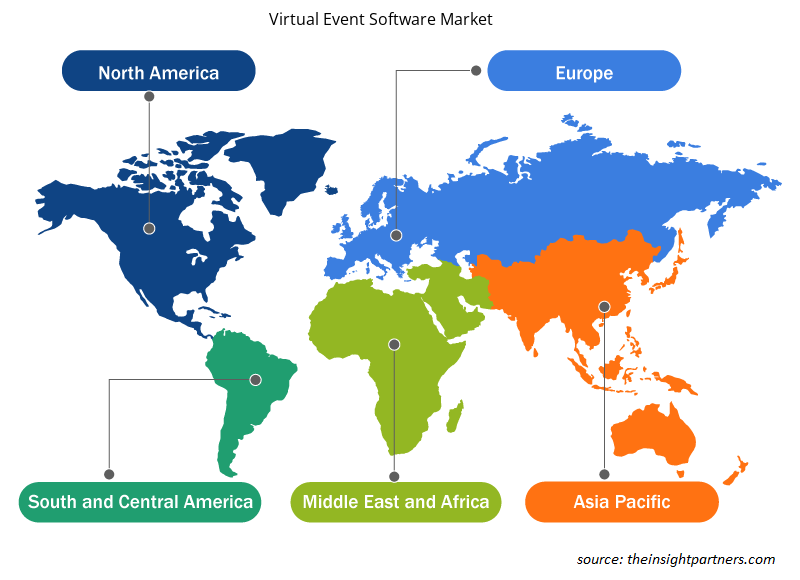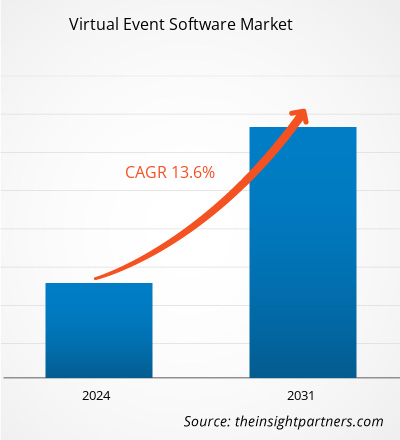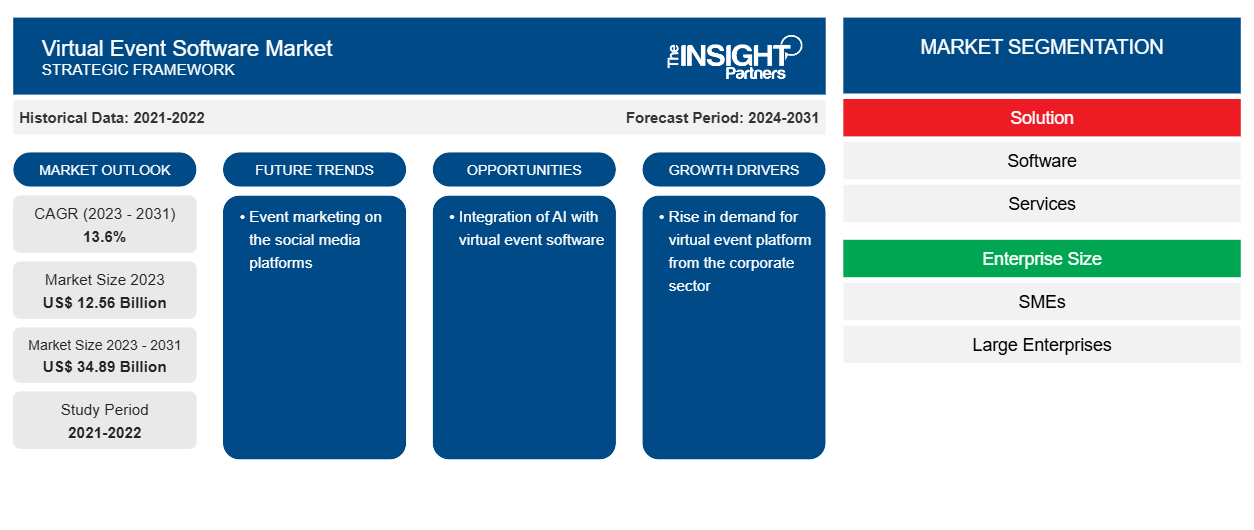Der Markt für virtuelle Event-Software soll von 12,56 Milliarden US-Dollar im Jahr 2023 auf 34,89 Milliarden US-Dollar im Jahr 2031 anwachsen. Der Markt wird zwischen 2023 und 2031 voraussichtlich eine durchschnittliche jährliche Wachstumsrate (CAGR) von 13,6 % verzeichnen. Das Wachstum bei virtuellen Events und die zunehmende Nutzung KI-basierter virtueller Event-Plattformen dürften weiterhin wichtige Trends auf dem Markt bleiben.
Marktanalyse für virtuelle Event-Software
Die virtuelle Event-Software gewinnt aufgrund von Faktoren wie der zunehmenden Internetdurchdringung, der zunehmenden Digitalisierung und der Förderung der Homeoffice-Kultur im Unternehmenssektor an Bedeutung. Die Fähigkeit der virtuellen Event-Software, die Teilnehmer mit verschiedenen ansprechenden Funktionen wie Einzelinteraktionen, Q&A-Umfragen, Live-Chats, Emoticons und anderen einzubinden, treibt ihre Nachfrage bei verschiedenen Endbenutzern wie Unternehmen, Eventmanagement-Unternehmen, Messeveranstaltern, akademischen Einrichtungen und anderen voran.
Marktübersicht für virtuelle Event-Software
Mithilfe von virtueller Event-Software können Sie Events virtuell und effizient durchführen. Sie bietet dieselben Funktionen wie Eventmanagement-Software. Der einzige Unterschied besteht darin, dass Eventmanagement-Software auch die persönliche Verwaltung des Events umfasst. Virtuelle Event-Software verfügt über Funktionen wie In-Webcasting und lässt sich nahtlos in Webinar-Software integrieren. Sie kann interaktive Inhalte wie Gruppenchats, Q&A-Umfragen und 1:1- Networking integrieren . Der Benutzer kann außerdem von jedem beliebigen Gerät aus an der Veranstaltung teilnehmen.
Passen Sie diesen Bericht Ihren Anforderungen an
Sie erhalten kostenlos individuelle Anpassungen an jedem Bericht, einschließlich Teilen dieses Berichts oder einer Analyse auf Länderebene, eines Excel-Datenpakets sowie tolle Angebote und Rabatte für Start-ups und Universitäten.
-
Holen Sie sich die wichtigsten Markttrends aus diesem Bericht.Dieses KOSTENLOSE Beispiel umfasst eine Datenanalyse von Markttrends bis hin zu Schätzungen und Prognosen.
Treiber und Chancen auf dem Markt für virtuelle Event-Software
Steigende Nachfrage nach virtuellen Event-Plattformen aus dem Unternehmenssektor begünstigt den Markt
Der Unternehmenssektor erfreut sich wachsender Beliebtheit virtueller Zusammenkünfte, was einer der Hauptfaktoren ist, die den Bedarf an virtuellen Veranstaltungsplattformen antreiben. Die Welle der digitalen Transformation, die COVID-19-Pandemie und die Homeoffice-Kultur im Unternehmenssektor haben den Bedarf an einer Lösung erzeugt, um die Mitarbeiter und Stakeholder des Unternehmens auf einer einzigen integrierten Plattform einzubinden. Große Unternehmen haben ihre Mitarbeiter auf der ganzen Welt. Für die Teambuilding-Aktivitäten organisieren die Unternehmen verschiedene Veranstaltungen, bei denen sich ihre Mitarbeiter engagieren können. Teambuilding-Veranstaltungen helfen Unternehmen dabei, ein leistungsstarkes Team aufzubauen und einen Raum für Mitarbeiter zu schaffen, in dem sie interagieren und mehr über die unterschiedlichen Hintergründe und Erfahrungen der anderen erfahren können. Daher organisieren Unternehmen Veranstaltungen, um ein gesundes Arbeitsumfeld und gute Beziehungen zu den Mitarbeitern zu schaffen, was ihre Arbeitsproduktivität weiter steigert.
Integration von KI in virtuelle Eventsoftware
Integrierte Technologien für KI-Technologie helfen dem Benutzer, Muster und Erkenntnisse zu erkennen, um Lücken und Möglichkeiten aufzudecken, die die Funktionen von Software und Prozessen verbessern. KI-integrierte virtuelle Event-Software kann dabei helfen, Veranstaltungspläne und automatische Eventplanungen automatisch zu erstellen. Sie kann virtuelle Veranstaltungsorte und Stände anpassen. Sie hilft auch dabei, das persönliche Erlebnis auf den virtuellen Plattformen nachzubilden. Einige Marktteilnehmer bieten KI-basierte virtuelle Event-Plattformen an. EventsX beispielsweise ist eine KI-gesteuerte Plattform zum Organisieren, Vermarkten und Hosten des perfekten virtuellen, hybriden oder persönlichen Events. Sie bietet Echtzeit- und Nach-Event-Analysen, die den Benutzern helfen, die Erfahrungen der Kunden zu verstehen. Die Event-Analyse hilft ihnen auch, sich für ein zukünftiges Event zu verbessern, indem sie personalisierte Kundenerlebnisse verbessern.
Marktbericht zur virtuellen Event-Software – Segmentierungsanalyse
Wichtige Segmente, die zur Ableitung der Marktanalyse für virtuelle Event-Software beigetragen haben, sind Lösung, Unternehmensgröße und Endbenutzer.
- Basierend auf der Lösung ist der Markt für virtuelle Event-Software in Software und Dienstleistungen unterteilt. Das Softwaresegment hatte im Jahr 2023 den größten Marktanteil.
- Nach Unternehmensgröße ist der Markt in KMU und Großunternehmen segmentiert. Die KMU werden im Prognosezeitraum voraussichtlich die höchste durchschnittliche jährliche Wachstumsrate aufweisen.
- In Bezug auf die Endnutzer ist der Markt segmentiert in Messeveranstalter, Eventmanagement-Agenturen, Unternehmen, akademische Organisationen und andere. Das Unternehmenssegment wird voraussichtlich mit einer signifikanten durchschnittlichen jährlichen Wachstumsrate wachsen.
Marktanteilsanalyse für virtuelle Event-Software nach geografischer Lage
Der geografische Umfang des Marktberichts zur virtuellen Event-Software ist hauptsächlich in fünf Regionen unterteilt: Nordamerika, Asien-Pazifik, Europa, Naher Osten und Afrika sowie Süd- und Mittelamerika.
Der asiatisch-pazifische Raum wird im Prognosezeitraum voraussichtlich die höchste durchschnittliche jährliche Wachstumsrate aufweisen. Die zunehmende Digitalisierung, das Wachstum im Unternehmenssektor und die Verbreitung des Internets in der Region sind einige der Faktoren, die den Markt für virtuelle Event-Software im asiatisch-pazifischen Raum antreiben. Verschiedene Softwareunternehmen bauen ihre Präsenz und ihr Geschäft in der Region aus, was den Markt weiter antreibt. Der Fokus der Regierung auf die Förderung der Digitalisierung in der Region hat das Marktwachstum weiter unterstützt.
Regionale Einblicke in den Markt für virtuelle Event-Software
Die regionalen Trends und Faktoren, die den Markt für virtuelle Event-Software während des gesamten Prognosezeitraums beeinflussen, wurden von den Analysten von Insight Partners ausführlich erläutert. In diesem Abschnitt werden auch Marktsegmente und Geografien für virtuelle Event-Software in Nordamerika, Europa, im asiatisch-pazifischen Raum, im Nahen Osten und Afrika sowie in Süd- und Mittelamerika erörtert.

- Holen Sie sich regionale Daten zum Markt für virtuelle Event-Software
Umfang des Marktberichts zur virtuellen Event-Software
| Berichtsattribut | Details |
|---|---|
| Marktgröße im Jahr 2023 | 12,56 Milliarden US-Dollar |
| Marktgröße bis 2031 | 34,89 Milliarden US-Dollar |
| Globale CAGR (2023 - 2031) | 13,6 % |
| Historische Daten | 2021-2022 |
| Prognosezeitraum | 2024–2031 |
| Abgedeckte Segmente |
Nach Lösung
|
| Abgedeckte Regionen und Länder |
Nordamerika
|
| Marktführer und wichtige Unternehmensprofile |
|
Dichte der Marktteilnehmer für virtuelle Event-Software: Die Auswirkungen auf die Geschäftsdynamik verstehen
Der Markt für virtuelle Event-Software wächst rasant, angetrieben durch die steigende Nachfrage der Endnutzer aufgrund von Faktoren wie sich entwickelnden Verbraucherpräferenzen, technologischen Fortschritten und einem größeren Bewusstsein für die Vorteile des Produkts. Mit steigender Nachfrage erweitern Unternehmen ihr Angebot, entwickeln Innovationen, um die Bedürfnisse der Verbraucher zu erfüllen, und nutzen neue Trends, was das Marktwachstum weiter ankurbelt.
Die Marktteilnehmerdichte bezieht sich auf die Verteilung der Firmen oder Unternehmen, die in einem bestimmten Markt oder einer bestimmten Branche tätig sind. Sie gibt an, wie viele Wettbewerber (Marktteilnehmer) in einem bestimmten Marktraum im Verhältnis zu seiner Größe oder seinem gesamten Marktwert präsent sind.
Die wichtigsten Unternehmen auf dem Markt für virtuelle Event-Software sind:
- Cvent Inc.
- EventMobi (5Touch Solutions Inc.)
- Hopin
- Hubilo Technologies Inc.
- lnEvent, Inc
- Pathable, Inc.
Haftungsausschluss : Die oben aufgeführten Unternehmen sind nicht in einer bestimmten Reihenfolge aufgeführt.

- Überblick über die wichtigsten Akteure auf dem Markt für virtuelle Event-Software
Neuigkeiten und aktuelle Entwicklungen zum Markt für virtuelle Event-Software
Der Markt für virtuelle Event-Software wird durch die Erfassung qualitativer und quantitativer Daten nach Primär- und Sekundärforschung bewertet, die wichtige Unternehmenspublikationen, Verbandsdaten und Datenbanken umfasst. Nachfolgend sind einige der Entwicklungen auf dem Markt für virtuelle Event-Software aufgeführt:
- Visit Maldives hat seine allererste virtuelle Eventmanagement-Plattform eingeführt. Die moderne Plattform mit dem Namen „My Virtual Maldives“ verstärkte die Einbindung und Vernetzung des Publikums, indem sie Teilnehmer aus der ganzen Welt durch gehostete Online-Events verband, die von virtuellen Ausstellungen, Roadshows und Webinaren bis hin zu Schulungen und Live-Marketing-Events reichten, die sich gleichermaßen an die Reisebranche und Verbraucher richteten. Das webbasierte Format ermöglicht höchste Zugänglichkeit und einfache Navigation, sodass die Teilnehmer die Leistungsfähigkeit der Virtualisierung auf unserer robusten Plattform und ihren Funktionen erleben können, wie z. B. KI-gestütztes Matchmaking, intelligente Lead-Generierung, virtuelle Stände, hybride Engagement- und Networking-Tools, Echtzeit-Support, Live-Videoanrufe und Text-Chat und mehr. (Quelle: Visit Maldives, Pressemitteilung, April 2021)
- Chati, ein branchenführender Anbieter umfassender Lösungen für virtuelle und hybride Events, gab die Einführung seiner virtuellen Eventplattform bekannt, die die Art und Weise verändern soll, wie Unternehmen, Organisationen und Gemeinschaften in virtuellen und hybriden Umgebungen mit einem globalen Publikum interagieren. Die Plattform von Chati ebnet den Weg für bemerkenswerte Erlebnisse und wertvolle Interaktionen für Gastgeber von Self-Service- und Full-Service-Events. Seine einzigartige Kombination aus Funktionen, darunter immersive Inhaltsvorlagen, anpassbare 3D-Räume, Gamification, Eventregistrierung und Ticketverkauf sowie Integrationsfunktionen, positioniert Chati fest als neuen Maßstab in der Online-Eventbranche für Unternehmen jeder Größe und Art. (Quelle: Chati, Pressemitteilung, August 2023)
Marktbericht zu virtueller Event-Software – Umfang und Ergebnisse
Der Bericht „Marktgröße und Prognose für virtuelle Event-Software (2021–2031)“ bietet eine detaillierte Analyse des Marktes, die die folgenden Bereiche abdeckt:
- Marktgröße und Prognose für virtuelle Event-Software auf globaler, regionaler und Länderebene für alle wichtigen Marktsegmente, die im Rahmen des Berichts abgedeckt sind
- Markttrends für virtuelle Event-Software sowie Marktdynamiken wie Treiber, Einschränkungen und wichtige Chancen
- Detaillierte PEST/Porters Five Forces- und SWOT-Analyse
- Marktanalyse für virtuelle Event-Software mit Blick auf wichtige Markttrends, globale und regionale Rahmenbedingungen, wichtige Akteure, Vorschriften und aktuelle Marktentwicklungen
- Branchenlandschaft und Wettbewerbsanalyse, einschließlich Marktkonzentration, Heatmap-Analyse, prominenten Akteuren und aktuellen Entwicklungen für den Markt für virtuelle Event-Software
- Detaillierte Firmenprofile
- Historische Analyse (2 Jahre), Basisjahr, Prognose (7 Jahre) mit CAGR
- PEST- und SWOT-Analyse
- Marktgröße Wert/Volumen – Global, Regional, Land
- Branchen- und Wettbewerbslandschaft
- Excel-Datensatz
Aktuelle Berichte
Verwandte Berichte
Erfahrungsberichte
Grund zum Kauf
- Fundierte Entscheidungsfindung
- Marktdynamik verstehen
- Wettbewerbsanalyse
- Kundeneinblicke
- Marktprognosen
- Risikominimierung
- Strategische Planung
- Investitionsbegründung
- Identifizierung neuer Märkte
- Verbesserung von Marketingstrategien
- Steigerung der Betriebseffizienz
- Anpassung an regulatorische Trends























 Kostenlose Probe anfordern für - Markt für virtuelle Eventsoftware
Kostenlose Probe anfordern für - Markt für virtuelle Eventsoftware